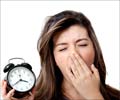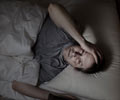Washington, Nov 1 (ANI): A new research has shown the first demonstration of a specific neurochemical abnormality in adults with primary insomnia, a finding which sheds light on the limited understanding of the condition's pathology.
The research has been published in the Nov. 1 issue of the journal Sleep.Results indicate that gamma-aminobutyric acid (GABA), the most common inhibitory transmitter in the brain, is reduced by nearly 30 percent in individuals who have been suffering from primary insomnia for more than six months.
The findings suggest that primary insomnia is a manifestation of a neurobiological state of hyperarousal, which is present during both waking and sleep at physiological and cognitive levels.
"GABA is reduced in the brain of individuals with insomnia, suggesting overactivity is present not only at the level of excessive thoughts and emotions, but can also be detected at the level of the nervous system," said principal investigator Dr. John Winkelman of Brigham and Women's Hospital, which is a teaching affiliate of Harvard Medical School in Boston, Mass.
GABA decreases overall activity in many brain areas, helping the brain to "shut down." Having a "racing mind" and an inability to shut down at night is a common complaint of people with primary insomnia.
Most often insomnia is a "comorbid" disorder, present with another medical illness, mental disorder or sleep disorder, or associated with certain medications or substances.
Advertisement
"Recognition that insomnia has manifestations in the brain may increase the legitimacy of those who have insomnia and report substantial daytime consequences," he said.
Advertisement
The preliminary study included 16 participants (eight men and eight women) who were screened to be free of medical and sleep disorders, as well as anxiety and mood disorders, and who were not taking prescription medication. Ages ranged from 25 to 55 years. Researchers recruited people who had difficulty initiating or maintaining sleep with resulting daytime distress or dysfunction for a period of at least six months.
The average duration of participants' symptoms was 10 years. Objective data were collected by actigraphy and overnight polysomnography. Proton magnetic resonance spectroscopy (1H-MRS) was used to non-invasively determine GABA levels. For statistical comparison the study included a well-matched control group consisting of seven women and nine men.
Significant correlations were found between GABA levels and both subjective and objective sleep measures after adjusting for age, body mass index (BMI) and gender. In subjects with primary insomnia, sleep continuity, as measured by minutes of wake after sleep onset (WASO) on sleep study, was strongly associated with GABA levels.
Source-ANI
SRM















